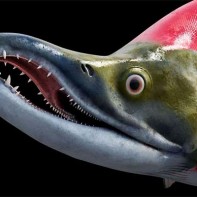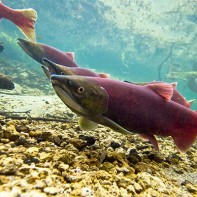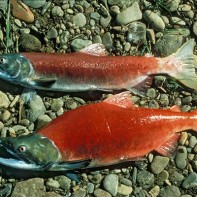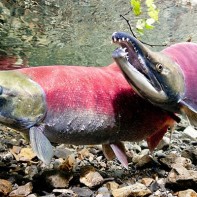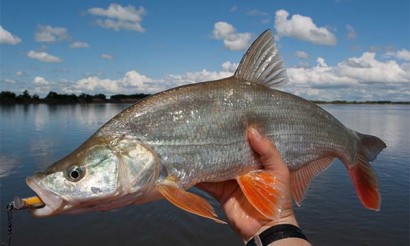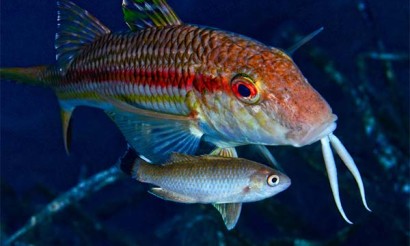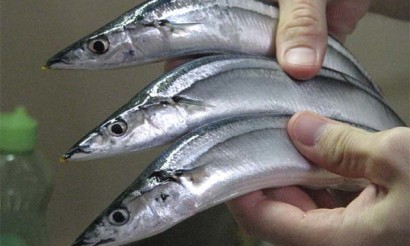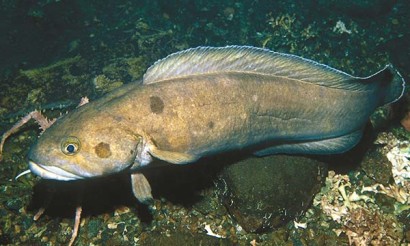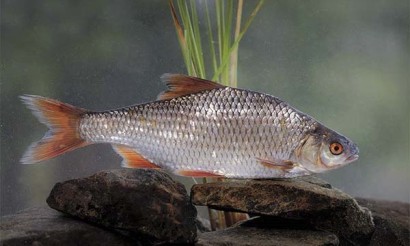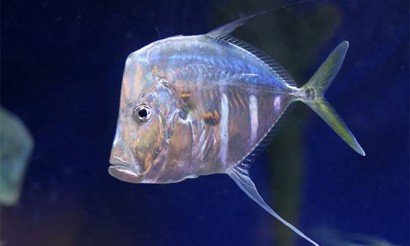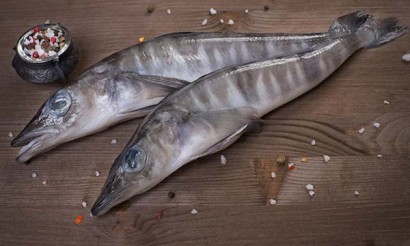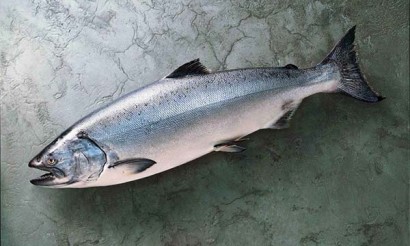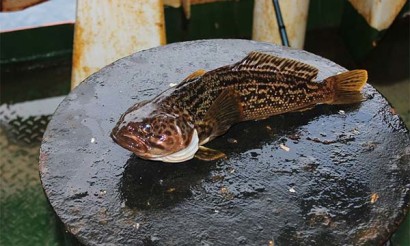Nerka fish (redfish): description, useful properties, recipes
Nerka, redfish, reddish are the names of one species of migratory fish, forming a living dwarf subspecies. Unlike other salmon, the commercial fish has a bright red color of meat and more often spawns not in rivers, but in lakes, which is not typical for other members of this family.
- The sockeye: what kind of fish, how it looks and where it is found
- Types
- What does it look like
- Where does it live
- What does it eat
- How long does it live
- Natural enemies
- Spawning
- Population and status of the species
- How to catch sockeye salmon
- Bay calendar
- Fishing Options
- What to catch
- How to find sockeye salmon in the pond
- In lakes
- In rivers
- At sea
- Reservoirs
- What is the difference between sockeye and coho salmon?
- Nurka or silver salmon: which is better?
- Which fish is better: chum salmon or coho salmon?
- Composition and calories
- Useful properties of the nerka
- Can children and pregnant women eat fish?
- Harm and contraindications
- The caviar of the sockeye salmon: benefits and harms
- How to choose and store the fish
- Where to buy and how much costs
- How to cook the seal
- In the oven
- In a pan
- Recipe for Nervous Fish Cutlets
- Nervous soup
- How to salt the nerka at home
- Q&A
- What does the caviar taste like?
- What color is the meat?
- Are there many bones in the fish?
- Which fish is fattier: Nervous or silver salmon?
Nerka: What kind of fish is it, what does it look like and where does it live?
Excellent taste of meat, roe and the difficulty of catching it makes the seal a delicacy for gourmets, an attractive target for anglers, sport fishing and recreational fishing.
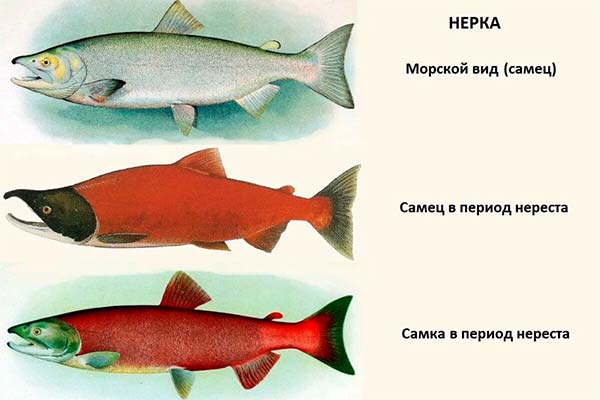
Types
The passable form of sockeye, which lives most of its life in seawater, is called silverfish for the color of its scales. The only subspecies of kokanee is a freshwater 30-cm fish that weighs no more than 0.7 kg. Kokanee live in lakes in North America, Japan, Kamchatka, and the Kuril Islands.
The subspecies differs from the silverside by its shortened snout, tall head, and the presence of numerous spots on the greenish back and tail. The sides of the fish are silvery with a pink tinge. During the spawning period the changes are present, but not as pronounced as in the silverside. The hump does not grow, the upper jaw is not distorted.
What does it look like?
The angular body of the seal is elongated in length, flattened on the sides. The protrusions and transitions are necessary to improve hydrodynamics during movement. The body shape of the fish is similar to that of chum salmon. Its average weight is 1.5-3 kg with a length of 40 cm; the maximum weight is 8 kg with a body length of 80 cm.
The silvery scales, tight to the body, are greenish and blue in color closer to the back. The head with round mobile eyes and a medium-sized mouth is rounded.
During the spawning migration, the head turns green, the body turns red, the jaw stretches and curves.
Where does it live
The range of the seal extends to the coastal waters of North America and the Asian Pacific coast. The redfish are especially abundant off the coast of Alaska, in western Canada. In Japan, the dwarf subspecies is artificially bred in freshwater lakes on Hokkaido Island.
In Russia, the Siberian seal is abundant in rivers, lakes, on the west and east coasts of Kamchatka, Chukotka, and in Lake Krasivoye on the Kuril Islands of Iturup. Small herds are found in the Sea of Okhotsk and enter the territorial waters of Islet Island. Sakhalin and into the Taiga River in northern Khabarovsk Krai.
What does it eat?
The sockeye are omnivores by nutritional behavior. Juveniles feed exclusively on zooplankton. Juveniles feed mainly on crustaceans, paddleworms, and insects.
Mature specimens eat zooplankton, small crustaceans, mollusks, bottom invertebrates, fry, and small fish.
Calanid crustaceans, which form the basis of the diet before the spawning migration, saturate the seal with carotene and color the meat red.
How long does it live
The life expectancy of redfish depends on the amount of benthic benthos near the spawning grounds and the habitat conditions of adults. On average, freshwater kokanee live 6 years, silverfish 5 years. The first two years the young fatten their weight in lakes and rivers, the next three - in the seas, the ocean.
Natural Enemies
Seals are hunted by Pacific sharks, seals, otters, and birds of prey (osprey, eagle). Especially vulnerable are fry, eggs and fish going to spawn. Bears wait for fish near river mouths and on rivers, which affects up to 30 percent of producers.
The main damage to the population is caused by poachers who kill fish for caviar, leaving carcasses with ripped up bellies on the shore.
Spawning
The spawning migrations of sockeye salmon begin in May and end in the fall. Fish herds approach the coast, waiting for the right moment to enter rivers, streams, and lakes. The sockeye rush to the spawning grounds, overcoming rapids with steep slopes and strong currents to get to the place where they hatch from the eggs.
Suitable places for spawning are littoral lakes at a depth of 1-1.5 m, channels, springs, and streams with groundwater that prevents freezing.
When entering fresh water, fish stop feeding, and their meat releases a toxin that decomposes only when frozen for a long time.
Females use their tails to dig a hole up to 30 cm deep in the sandy-pebble bed where they lay their eggs. The male fertilizes it, and the pair works together to cover the nest with stones. There can be up to five such clutches during the spawning period.
The females, leaving their young, die, the male guards the nest for some more time and soon dies, too. Thus, the parents provide food for the fry that hatched in winter until March. Young fry fatten in fresh water for 1-2 years, then migrate downstream to the sea, where they live until they become sexually mature, which occurs by the age of five.
Population and status of the species
Predatory catch of sockeye salmon by the Japanese in the Sea of Okhotsk in the 1990s when drift nets blocked access to their spawning grounds dramatically reduced the population of the species. While in recent years the limits on the catch of Kamchatka sockeye salmon have been 30,000 tons annually, chum salmon and pink salmon are caught on an industrial scale in the Sea of Okhotsk, and sockeye salmon is caught as by-catch. The issue of the species' status was particularly acute in 2008, when the IUCN announced the extinction of some regional populations. Conservation measures taken by the state changed their status to minimally endangered.
The issue of combating poachers remains relevant. During fishing season in Kamchatka and Chukotka more than fifty stationary guard posts and mobile task forces that include freelance security inspectors, workers of the Ministry of Internal Affairs, border guards operate.
How to catch seals
To enjoy fishing and return home with a catch it is necessary to have the appropriate tackle, to know where and when the fish is found.
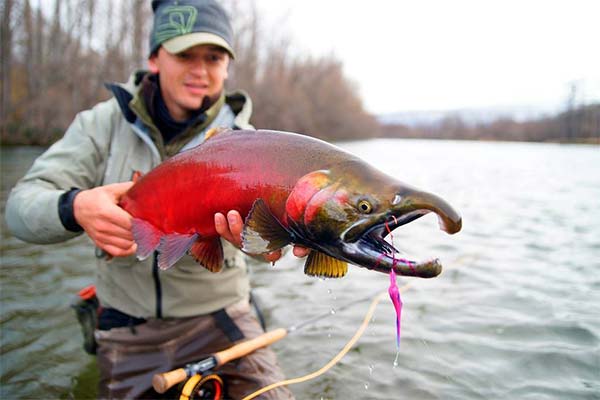
Bite Calendar
The redfish, like all living things, obeys biorhythms, which change depending on the season, time of day, weather. It has been noticed that the bite occurs more often from dawn to 9 o'clock and in the evening from 17 to 21 o'clock. At night, fish prefer to sleep.
The sockeye are most active in the spring after the melting of glaciers. It is actively gaining weight, accumulating energy before the spawning migration. At this time of the year the fish can be caught at dawn or in the late morning when the weather is cloudy.
In summer, the seal is caught in cold channels or in places where rivers flow into lakes, where underground springs with ice-cold water come to the surface. In the sea in summer the fish go below the upper layers warmed by the sun.
In the fall, the sockeye squander nutritional value on their way to spawning grounds and are of no value as a fishing target.
The dwarf subspecies of kokanee are caught in the winter. Licenses are issued for them year-round. The fish stay closer to the bottom of the lake where the water does not freeze.
Fishing options
The ways to fish for sockeye salmon do not differ from other salmon species, except that it is caught not only in the sea and rivers, but also in lakes.
Fishing for sockeye salmon by spinning is considered easier. Since the sockeye is a large fish, the tackle must be powerful. For fishing in rivers of fish weighing up to 5 kg rods are suitable rigid line length of 1,8-2,1 m with an open windup reel, line diameter of 0.3 mm. If the bait weighs more than 30 g, we need a thicker line and a multiplier reel.
In places with standing water bait held slowly near the fish. If you have to fish in areas with a strong current, the bait is thrown above the expected location of the fish, starting with a review of light baits.
When biting neshka nurse sharply, trying to stop her or go on a trick and let the fish swim downstream, moving along the shore and gradually reeling in the line, forcing the redfish closer to shore.
To fly fishing, use long rods 2,7-5 m based on local conditions, inertial reels with a diameter of 12 cm, strong cords, flies as bait.
In small channels, the tackle is directed downstream, with short jerks pulling it up. On the fast rapids of large rivers bait is thrown across the stream, thereby increasing the catching area.
What to catch
The most common baits when fishing for sockeye by spinning - silver wobblers, spinning, oscillating lures weighing from 10 to 40 g. When fishing by fly fishing use artificial fly fancy or resembling insects up to 8 cm long. The fish also responds well to colored deer hair tied to a tee.
In spring, when the redfish is most active, knit the biggest flies, in summer - 3 cm long. The color of the bait depends on the weather, water transparency, depth of casting. With good visibility fish prefer light monochrome baits. When fishing at depth in muddy holes or in cloudy weather, fishermen choose tins of acid colors.
How to find sockeye in the pond
Fisherman's luck depends not only on the tackle and fishing techniques, but also on the ability to choose the location of the seal.
In Lakes
In lakes, young sockeye spend the first 2 years of their lives, and if the food supply is large, they can stay up to 4 years. The lake seal is searched for at a depth of 1-10 m depending on the seasonal movement of the benthos.
In rivers.
The silverfish are caught in the quiet backwaters of spawning rivers, in which food is brought in from fast channels upstream. The best spot is a bend in the river with a shoreline shingle opposite a concave coastal section of the river with great depth.
At sea
During the spawning season the seal reaches the shoreline area at river mouths. Here at shallow depths the fish are caught by fixed nets.
In reservoirs
The dwarf subspecies of kokanee seal keeps away from noisy hydraulic structures. The fish can be found at a distance of 1 thousand meters from the dam and the generator rotors.
What is the difference between nika and chum and coho salmon?
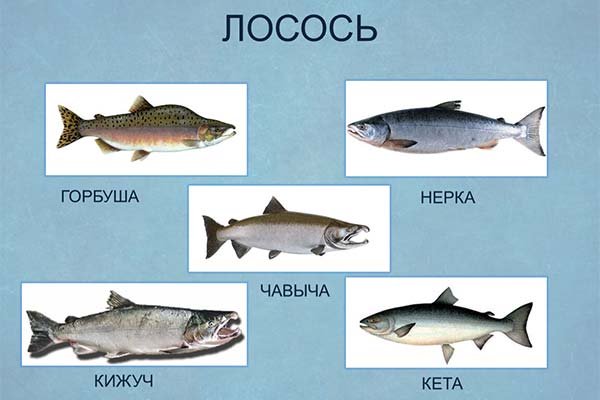
The driest and palest meat is chum salmon. It is followed by coho salmon. Of the three fish species, the most fatty is the sockeye. All salmon have fat distributed evenly between muscle fibers and contain polyunsaturated Omega-3 fatty acids.
Nerka is distinguished by its bright red color and peculiar taste. During repeated defrosting, red salmon meat breaks up into layers, which is not so noticeable with other salmon.
The coho salmon is larger than the chum salmon, and the latter weighs more than the sockeye.
The silver salmon is more expensive than other species of fish with red meat and it is not so much due to its taste qualities as to the limited fishing grounds and the number of the population.
Nerka or coho salmon: which is better?
In a comparison of two species of rare salmon species, consumers put first place in terms of taste coho salmon. Tender red meat with a spicy bitterness is used to prepare exquisite second courses in Michelin-starred restaurants. Slightly less popular with chefs and housewives is coho salmon with its bright, peculiar taste and tougher muscle fibers.
Nerka and coho salmon contain vitamins D, A, E, group B, a complex of minerals, Omega-3,6 fatty acids. But doctors often recommend using coho salmon for diabetes to stabilize blood glucose levels.
Which fish is better: chum salmon or sockeye salmon?
Nerka is fattier, tastier, its vitamin and mineral complex is more diverse and richer. Chum salmon is drier, with less protein and nutrients, since 75 percent of the fish consists of water.
Low-calorie chum salmon is more suitable for people who want to get rid of excess weight. Caviar of this species of salmon is in high demand among buyers because of the large orange-red eggs with a creamy aftertaste.
Composition and calories
The energy value of 100 g of edible part of the sockeye salmon is 157 kcal. GI - 20, 8.4 and 0 g, respectively.
Vitamins and minerals contained in 100g:
Vitamins:
- Cobalamin - 7.8 µg;
- Calciferol - 11 µg;
- Nicotinic acid - 9.5 mg;
- Pantothenic acid - 1.1 mg;
- Choline - 95 mg;
- Pyridoxine - 0.3 mg;
- Thiamine - 0.2 mg;
- Tocopherol - 1.8 mg;
- Riboflavin - 0.2 mg;
- Folate - 11 µg;
- Ascorbic acid - 1 mg.
Micronutrients:
- Cobalt - 20 µg;
- Chromium - 55 micrograms;
- Selenium - 30 micrograms;
- Iodine - 50 micrograms;
- Fluorine - 430 µg;
- Zinc - 0,7 mg;
- Molybdenum - 4 µg;
- Copper - 52 µg;
- Iron - 0.5 mg;
- Manganese - 0.01 mg.
Macronutrients:
- Phosphorus - 210 mg;
- Sulfur - 203 mg;
- Potassium - 390 mg;
- Chlorine - 165 mg;
- Magnesium - 24 mg;
- Sodium - 47 mg;
- Calcium - 7 mg.
Nerka contains 1,5 g per 100 g of saturated fats, 2,5 g of monounsaturated and 1,6 polyunsaturated fatty acids.
Useful properties of Nerka
Nerka is valued for its quality proteins, healthy fats that take part in intracellular biochemical reactions and for the rich vitamin and mineral complex in its composition.

When nerka is eaten twice a week:
- cholesterol, blood sugar levels are normalized;
- Neutralizes the effects of toxins;
- Thyroid dysfunction, liver cancer, prostate cancer are prevented;
- Mucous membranes are prevented from drying out;
- prolongs cell youthfulness due to antioxidant properties;
- Supports the health of female and male reproductive organs;
- Metabolism processes are normalized;
- It reduces the recovery period after childbirth, illnesses, injuries and operations;
- Supports the work of the heart, nervous, digestive system;
- the lumen of blood vessels increases;
- swelling goes down;
- Enzymes, hormones, phospholipids in the liver are synthesized in the right quantity;
- Adrenal functions are improved.
In 100 grams of redeye meat contains more than 260% of the daily norm of cobalamin, 110% of vitamin D and 48% of vitamin PP. Dish made of redfish saturates the body with iodine, phosphorus, potassium, selenium and zinc. Minerals support the proper functioning of the central nervous system, provide the formation of blood cells, energy and lipid metabolism, the respiration process. Micro and macro elements are included in the structure of tissues and organs, protect against external adverse factors.
Can children and pregnant women eat fish?
Fish is introduced into the children's diet from 3 years old. Nerka contains a lot of easily digestible protein that can absorb the imperfect digestive system of the child. Vitamin D prevents the development of rickets by strengthening bone tissue. Iodine affects mental development, supports thyroid function.
Burke in boiled, baked form is also useful for mothers-to-be. Fish meat calms the nervous system, improves immune defense. Pregnant women who eat nerka once or twice a week get fewer cold infections. They are not bothered by swelling, cramps of the calf muscles. The risk of fetal abnormalities is reduced.
Harm and contraindications
In children under three years of age, when using redfish, the risk of allergic reactions increases. It is worth refraining from fish dishes at exacerbation of gastritis, peptic ulcer disease, pancreatitis, intolerance of the product.
If there is no or insufficient heat treatment can be infected with worms. Note that fish can accumulate in the muscle mercury compounds, salts of heavy metals. During the spawning period, the content in the meat increases dangerous to health toxins.
Caviar of the seal: benefits and harms
The useful properties of the caviar of the seal are due to its chemical composition:
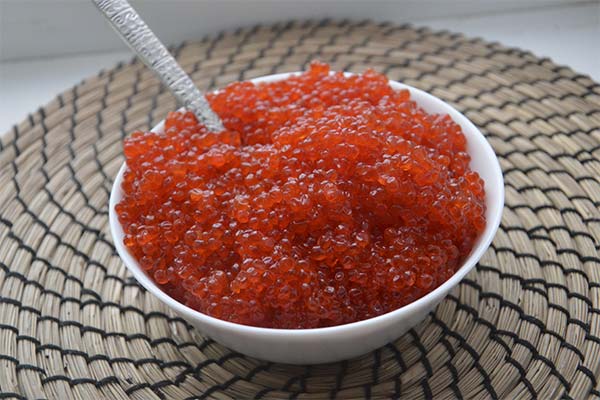
- Omega-3 fatty acids regulate the work of systems, internal organs, support joint mobility, youthful skin, elasticity of blood vessels.
- Thiamine improves metabolism.
- Retinol supports the immune system and is responsible for reproductive health.
- Riboflavin increases the acuity of twilight and light vision.
- Calcium makes denser bone tissue, strengthens dental enamel.
- Magnesium plays a role as a tranquilizer and anti-stress.
- Phosphorus is involved in the synthesis of hormones, enzymes, lipid and protein metabolism.
Nourishing delicacy product quickly fills with energy, increases endurance, reduces the rehabilitation period after a serious illness, surgical intervention.
Snapper caviar is harmful if consumed in excess. The high salt content in the product leads to high blood pressure, edema, kidney malfunction.
How to choose and store fish
When selecting the nerka take into account that fresh, healthy fish should not have:
- cloudy, sunken eyes;
- Pale meat
- Gills other than red and pink;
- Foreign odors;
- thick layer of glaze, indicating repeated freezing;
- mechanical damage to the skin, spots of unknown origin.
The freshness of chilled fish can be checked by pressing with a finger on the carcass. If the formed hole immediately disappears, the fish is of high quality.
Where to buy and how much costs
It is more reliable to buy sockeye in specialized fish stores or large supermarkets, which value their reputation, work with trusted suppliers and have the appropriate equipment.
The price for redfish per 1 kg:
- fresh-frozen - 870- 1100 p.;
- filet - 1400-1700 rubles;
- steaks -1200-1400 rubles;
- Russian smoked sturgeon - 1800 rubles.
High prices are explained by the small population size and catch quotas limitation.
How to cook sockeye salmon
Nerka is good because it does not require long cooking, complex sauces and recipes. It is enough pepper, salt and lemon juice to get a tasty nutritious dish. The fish is boiled, baked, pan-fried and stewed. Very tasty salmon, lightly salted and smoked. Not only appetizers and second courses, but also a rich soup can be made from the cranberries.
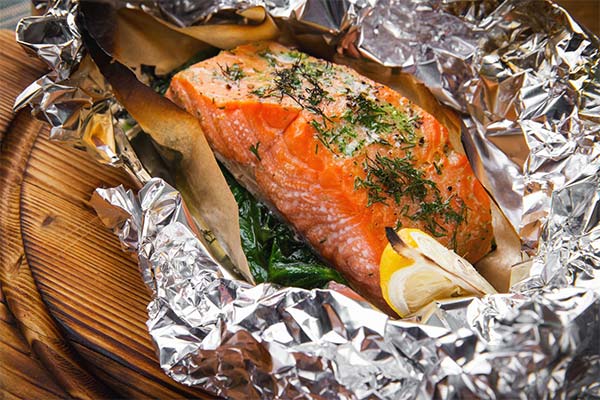
In the oven
Prepare:
- 5-6 steaks of nerka;
- 100g of hard cheese;
- 2 tbsp. lemon juice;
- 0.5 cup vegetable oil;
- pepper, salt.
Step by step guide for cooking nerka in foil in the oven:
- Defrost the fish, rinse, and let the water drain.
- Transfer the nerve to a bowl, sprinkle with salt, pepper, add vegetable oil, lemon juice, leave for one hour.
- Wrap steaks in foil, seal edges. You can not make individual envelopes, but lay the fish on one sheet of foil, cover with another.
- Send the tray with the contents to the oven heated to 180°C for 25 minutes. Unwrap the foil, sprinkle the fish with grated cheese, continue baking until golden crust.
The flavor of baked in foil nerka is enhanced by stewed carrots, zucchini, roasted broccoli, green beans, beets, French fries, and crumbly rice.
In the pan.
Before grilling, the steaks are washed, dried, salted, peppered and drizzled with lemon juice. After 15 minutes, when the fish is marinated, it is rolled in flour and sent to the frying pan. In hot oil fry steaks for 7 minutes on each side or longer. Cooking time depends on the thickness of pieces.
Fish with a golden crust is combined with grilled vegetables, fried or baked potatoes, rice, salad with fresh vegetables.
Recipe for fish cutlets with sockeye salmon
To prepare fish cutlets with potatoes you will need:
- 0.4 kg of the fillet of sockeye salmon;
- 1 egg;
- 2 tubers of potatoes;
- 2 cloves of garlic;
- half an onion;
- 100 g breadcrumbs for breading;
- 50 ml of vegetable oil;
- black pepper, salt.
Cooking algorithm:
- Cut the fillets into cubes, mince with garlic, onions or chop them with a blender.
- Boil potatoes in their peel, peel, grate, combine with fish mixture.
- Add seasoning, beat raw egg, knead stuffing until homogeneous.
- Form cutlets, each one roll in ground crumbs, put into a frying pan with hot oil.
- Fry the cutlets for 2 minutes on both sides on a high heat, finish cooking over a low flame under a lid.
Serve fish cutlets with a salad of fresh tomatoes, cucumbers, sweet peppers and mashed potatoes or boiled rice.
Fish soup made of nerka
To make the fish soup tasty you should cook its head with removed gills, spine and scraps of fins. Put the soup set in a saucepan with cold water. Add peppercorns, bay leaf, washed onion with husks to give the dish a flavor and golden color.
After a quarter of an hour in a pot with boiling broth put peeled and chopped potato tubers (4 pieces) and one carrot. After another 20-25 minutes, remove the head and backbone, separate edible parts from bones, return them back into the container.
At the final stage, salt the soup, add chopped parsley and dill greens. After turning off the stove, let the dish infuse for 10-15 minutes. Serve soup hot or cold.
How to salt fish at home

For salting red fish it is better to buy a whole frozen fish, cut it into fillets by yourself. Prepare salted seal in brine or dry salting.
In the first case, 150 g of salt and 50 g of sugar are dissolved in two liters of warm boiled water. Squeeze the juice of one lemon and add it to the brine and pour the ready fillet (2 kg) cut into pieces. To salt the fish evenly, press it with a plate and put it in the cold place.
After 12 hours the liquid is drained off, the fish is transferred into a food container, poured in oil and returned to the refrigerator. In total the seal is salted for one day, in oil it retains its consumer properties for up to seven days.
With dry salting method the same proportions of salt and sugar (3:1) apply. Pieces of fillets pour sweet and salty mixture, put in a container that is placed in the refrigerator. After 4 hours, salted nerka is ready.
Q&A
Consumers are more often interested in information about the color, meat characteristics and boneiness of the fish.
What does the caviar of the sockeye salmon taste like?
Bright red small (up to 4 mm) caviar of the seal has a soft shell, a pronounced fishy taste with a bitterness.
What color is the meat?
The rich red color of the meat can be explained by the eating habits of the seals. The fish prefers red calanid crustaceans, whose pigment passes into the meat, to other foods.
Are there many bones in the fish?
Nerka, like other salmonids, cannot be called bony. The fish skeleton consists of a spine (backbone), large rib bones, which are easily separated from the meat when cutting the carcass into fillets.
Which fish is fattier: Nyika or coho?
If you compare species of fish in terms of fat content, the latter is fattier and more caloric. The fat content in 100 grams of raw coho salmon is 5.9 g, while that of sockeye is 8.4 g.
To improve health, to get gastronomic pleasure from the dishes of coho salmon, the fish should be properly selected, cooked and consumed, taking into account the possible harms and contraindications.
«Important: All information on this site is provided for informational purposes only. for your own health. Consult with your health care professional before applying any recommendations. specialist. Neither the editors nor the authors are liable for any possible harm caused by materials."



